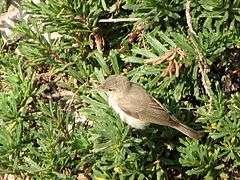Eastern olivaceous warbler
| Eastern olivaceous warbler | |
|---|---|
 | |
| Scientific classification | |
| Kingdom: | Animalia |
| Phylum: | Chordata |
| Class: | Aves |
| Order: | Passeriformes |
| Family: | Acrocephalidae |
| Genus: | Iduna |
| Species: | I. pallida |
| Binomial name | |
| Iduna pallida (Hemprich & Ehrenberg, 1833) | |
| Synonyms | |
|
Hippolais pallida (Ehrenberg, 1833) | |

The eastern olivaceous warbler (Iduna pallida) is a "warbler", formerly placed in the Old World warblers when these were a paraphyletic wastebin taxon. It is now considered a member of the acrocephaline warblers, Acrocephalidae, in the tree warbler genus Iduna. It was formerly regarded as part of a wider "olivaceous warbler" species, but as a result of modern taxonomic developments, this species is now usually considered distinct from the western olivaceous warbler, Iduna opaca.[2]
Keyserling and Blasius gave no explanation of the genus name Iduna. The specific pallida is Latin for "pale".[3]
It is a small passerine bird, found in dry open country, including cultivation, with bushes or some trees. 2-3 eggs are laid in a nest in low in undergrowth or a bush. Like most warblers, Eastern Olivaceous is insectivorous.
It is a medium-sized warbler, more like a very pale reed warbler than its relative the melodious warbler. The adult has a plain pale brown back and whitish underparts. The bill is strong and pointed and the legs grey. The sexes are identical, as with most warblers, but young birds are more buff on the belly. It has a characteristic downward tail flick.
Eastern olivaceous warbler breeds in south east Europe and the Middle East. It is migratory, wintering in sub-Saharan Africa or Arabia. It is a rare vagrant to northern Europe.
Western olivaceous warbler differs from this species in being larger and having a browner tinge to the upperparts; it also has a larger bill. Eastern olivaceous warbler sometimes has a greenish tinge to its upperparts, and can be very difficult to separate from Sykes's warbler, Iduna rama. The song is a fast nasal babbling.
Distribution
North Africa
Eastern olivaceous warbler of the subspecies reiseri is thought to be locally common as a breeding species in southeast Morocco.[4]
References
| Wikispecies has information related to: Hippolais pallida |
- ↑ BirdLife International (2008). "Hippolais pallida". IUCN Red List of Threatened Species. Version 2008. International Union for Conservation of Nature. Retrieved 18 May 2009.
- ↑ Silke Fregin; Martin Haase; Urban Olsson; Per Alström (2009). "Multi-locus phylogeny of the family Acrocephalidae (Aves: Passeriformes) – The traditional taxonomy overthrown". Molecular Phylogenetics and Evolution. 52 (3): 866–878. doi:10.1016/j.ympev.2009.04.006. PMID 19393746.
- ↑ Jobling, James A (2010). The Helm Dictionary of Scientific Bird Names. London: Christopher Helm. pp. 202, 289. ISBN 978-1-4081-2501-4.
- ↑ Salewski, Volker, Herbert Stark and Bernd Leisler (2009) Olivaceous Warblers in Southeast Morocco British Birds 102(3): 116-21
